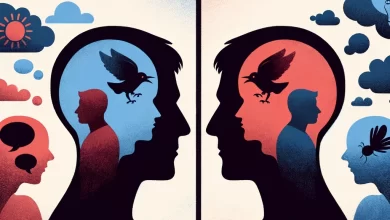Anxious Attachment: Tips for Healthier Relationships – Mindsterk

Did you know that approximately 20% of the population has an anxious attachment style?
Attachment theory, a psychological framework that explores how early experiences shape adult relationships, reveals the impact and prevalence of anxious attachment. People with this attachment style often require constant reassurance and affection to feel secure, fearing rejection and abandonment. This pattern stems from inconsistent caregiving during childhood and can manifest as clinginess and jealousy in adult relationships.
Key Takeaways:
- Anxious attachment affects around 20% of the population.
- It stems from inconsistent caregiving during childhood.
- Anxious attachers require constant reassurance and fear rejection.
- It can lead to clinginess and jealousy in relationships.
- Understanding this attachment style is crucial for building healthier dynamics.
What Causes An Anxious Attachment Style?
Attachment theory provides insights into the origins of different attachment styles, including the anxious attachment style. This theory suggests that early interactions with caregivers significantly impact later social interactions and relationships.
A secure attachment style is formed when caregivers consistently meet the emotional needs of a child and respond to their cues with sensitivity and attunement. On the other hand, inconsistent caregiving can lead to the development of an anxious attachment style.
Children with anxious attachment struggle to trust their caregivers and may experience separation anxiety and difficulties with emotional regulation. The inconsistent and unpredictable nature of their caregivers’ responses creates insecurity and uncertainty.
As these children grow into adults, their attachment style influences their romantic relationships and interactions with others. The patterns established in childhood can persist into adulthood, shaping the dynamics of their relationships and emotional well-being.
Attachment theory explains that early interactions with caregivers influence later social interactions and relationships.
Understanding the roots of an anxious attachment style can provide insight into the challenges faced by individuals with this attachment style. It highlights the importance of recognizing and addressing childhood attachment issues to foster healthier relationship dynamics in adulthood.
Effects of Inconsistent Caregiving
| Effects of Inconsistent Caregiving |
|---|
| Development of separation anxiety |
| Poor emotional regulation |
| Difficulty trusting others |
Anxious attachment resulting from inconsistent caregiving can have profound effects. It can lead to the development of separation anxiety, making it challenging for individuals to feel secure when apart from their loved ones.
Additionally, inconsistent caregiving can hinder the development of effective emotional regulation skills. Individuals with an anxious attachment style may struggle to manage their emotions and may become overwhelmed when faced with relationship challenges or perceived threats.
Moreover, inconsistent caregiving affects a child’s ability to trust others. The lack of consistent responsiveness from caregivers can create a sense of uncertainty and scepticism, making it difficult for individuals with an anxious attachment style to fully trust their partners in adult relationships.
The image above represents the importance of childhood attachment in shaping an individual’s attachment style.
Understanding the impact of inconsistent caregiving on attachment styles is vital in providing support and guidance to individuals with an anxious attachment style as they navigate their relationships and seek to develop more secure attachments.
What Is Anxious Attachment in Relationships?
Anxious attachment in relationships is characterized by a deep longing for intimate connections combined with a persistent fear of rejection and abandonment. Individuals with an anxious attachment style often question their own self-worth and seek constant validation from their partners. This attachment style can manifest in hypervigilance, clinginess, jealousy, and poor boundaries.
Relationships can provide a sense of comfort and security for anxiously attached individuals, but they can also trigger anxiety and heightened emotional reactivity. The fear of rejection and abandonment can cause them to doubt their partner’s feelings and intentions, leading to a constant need for reassurance and validation.
Emotional needs play a significant role in anxious attachment dynamics. Anxious attachers have a strong desire for emotional closeness, but their fear of rejection often creates a push-pull dynamic in relationships. They may struggle with effectively communicating their needs and may exhibit behaviours aimed at eliciting reassurance and attention.
It is important to recognize that anxious attachment in relationships can stem from childhood experiences and the way emotional needs were met or not met during that time. Understanding and addressing these underlying emotional patterns is crucial for creating healthier relationship dynamics.
Anxious Attachment in Practice
Anxious attachment can manifest in various ways in real-life scenarios. For instance, an anxiously attached individual may constantly seek affirmation and validation from their partner, often feeling insecure without it. This can result in a heightened sensitivity to signs of rejection, leading to jealousy and possessiveness.
Moreover, anxiously attached individuals may struggle with setting and maintaining healthy boundaries in relationships. Their fear of abandonment may cause them to sacrifice their own needs and boundaries in order to prevent their partner from leaving. This can lead to an unhealthy dependence on the relationship and a loss of individuality.
Anxiously attached individuals may also experience heightened anxiety in response to relationship conflicts or perceived threats to the relationship. Their fear of being abandoned intensifies during these situations, often resulting in emotional distress and the need for immediate reconciliation.
Building Secure Attachment:
While anxious attachment poses challenges, it is possible to develop a more secure attachment style through self-awareness, communication, and personal growth. Recognizing and understanding anxious attachment patterns is the first step towards building healthier relationship dynamics.
Practicing effective communication skills, such as expressing needs and boundaries, can help anxiously attached individuals establish a more secure foundation in their relationships. Additionally, working on self-esteem and self-compassion can reduce the reliance on external validation and foster emotional security.
Therapy and counselling can provide valuable support in exploring and healing underlying attachment wounds. Therapists trained in attachment theory can help individuals develop healthier coping mechanisms, manage anxiety, and build more secure attachment styles.
Characteristics of Anxious Attachment in Relationships
| Characteristics | Description |
|---|---|
| Fear of rejection | Constantly worried about being rejected by their partner. |
| Fear of abandonment | A deep-seated fear of being abandoned or left alone. |
| Seeking constant validation | Requires frequent reassurance and validation to feel secure. |
| Jealousy | Tendency to feel jealous and possessive in relationships. |
| Poor boundaries | Difficulty in setting and maintaining healthy boundaries. |
| Emotional reactivity | Highly responsive to emotional triggers, often overreacting. |
Signs of Anxious Attachment in Relationships:
Recognizing the signs of anxious attachment in relationships is crucial for understanding the dynamics at play and addressing potential challenges. Individuals with an anxious attachment style often exhibit behaviours that stem from their fear of rejection and abandonment. Here are some common signs to watch out for:
- Being highly attuned to the partner’s needs: Anxiously attached individuals are hyper-vigilant when it comes to their partner’s emotions and behaviours. They often prioritize meeting their partner’s needs, sometimes neglecting their own in the process.
- Seeking constant validation and reassurance: In an effort to alleviate their fear of rejection, anxious attachers may constantly seek validation from their partner. They rely on external reassurance to feel secure in the relationship.
- Experiencing fear of rejection and abandonment: Anxious attachers are plagued by a deep-seated fear of being rejected or abandoned by their partner. This fear can lead to heightened anxiety and insecurity in the relationship.
- Displaying jealousy and suspicion: Anxiously attached individuals may exhibit jealousy and suspicion due to their fear of losing their partner. They may scrutinize their partner’s interactions with others and feel threatened by perceived threats to the relationship.
- Struggling with boundaries: Poor boundaries are a common characteristic of anxious attachment. Anxious attachers may have difficulty establishing and maintaining healthy boundaries, leading to a blurred sense of self and dependency on their partner for emotional fulfilment.
- Experiencing excessive anxiety or worry: Anxiety and worry are constant companions for individuals with an anxious attachment style. They often anticipate negative outcomes and catastrophize situations, fueling their insecurities.
These signs of anxious attachment can be detrimental to relationships, often triggering avoidant behaviour in their partners. Without addressing and managing these patterns, the anxious attachment style can create ongoing challenges and hinder relationship growth.
How to Manage Anxious Attachment in Relationships:
Managing anxious attachment in relationships is essential for fostering healthy and fulfilling connections. By understanding the triggers and implementing effective strategies, you can create a more secure attachment style and improve the dynamics of your relationships. Communication and self-awareness play a crucial role in managing anxious attachment.
Understanding Triggers
Recognizing the patterns and triggers that contribute to your anxious attachment can help you gain a deeper understanding of your emotions and behaviours. Reflect on past experiences and identify situations that tend to provoke anxiety or insecurity. Building self-awareness around these triggers enables you to respond with intention and develop healthier coping mechanisms.
Improving Communication
Open and honest communication is key in managing anxious attachment. Share your feelings and concerns with your partner, expressing your needs and boundaries clearly. Creating a safe space for dialogue allows both partners to address insecurities, fears, and anxieties, fostering greater understanding and emotional support. By communicating effectively, you can build trust and develop a more secure attachment.
Developing a Secure Attachment
Working towards developing a secure attachment style is crucial for managing anxious attachment. Building a foundation of emotional security and self-compassion helps alleviate anxiety and fosters a healthier sense of self-worth. Seeking therapy or counselling can provide valuable insights and guidance on how to develop more secure and satisfying relationships.
| Strategies for Managing Anxious Attachment in Relationships |
|---|
| 1. Recognize and understand triggers |
| 2. Engage in open and honest communication |
| 3. Develop self-awareness |
| 4. Practice self-compassion |
| 5. Seek therapy or counselling |
By actively managing anxious attachment, you can build healthier and more fulfilling relationships. Remember, change takes time and effort, so be patient with yourself and prioritize self-care throughout the process.
Dating with An Anxious Attachment Style:
Dating with an anxious attachment style can present unique challenges, particularly in the realm of online dating. Anxious attachers often experience heightened levels of anxiety and insecurity when waiting for a response or trying to interpret their potential partner’s behaviour. The anonymity and ambiguity of online interactions can exacerbate attachment insecurity, leading to heightened emotional turmoil.
Ghosting, slow fade, and catfishing are prevalent dating challenges that can be particularly distressing for individuals with attachment insecurity. Ghosting refers to the sudden and unexplained disappearance of a romantic interest, leaving the anxious attacher feeling rejected and confused. The slow fade, on the other hand, involves a gradual reduction in communication and emotional investment, magnifying feelings of abandonment and unworthiness. Catfishing, where someone pretends to be someone they’re not online, plays on anxieties related to trust and authenticity.
Anxious attachers may find themselves caught in a cycle of seeking attention and validation through online dating platforms, hoping to alleviate their attachment anxiety. While offering temporary validation, online dating can reinforce insecurity by failing to meet the emotional needs of anxious attachers.
Approaching Online Dating with Caution and Self-Awareness
It is crucial for those with an anxious attachment style to approach online dating with caution and self-awareness. Recognizing their attachment insecurities and having open and honest communication about their needs and fears can pave the way for healthier and more fulfilling connections. Seeking professional guidance, such as therapy, can also provide valuable support in navigating the challenges of dating with an anxious attachment style.
In summary, dating with an anxious attachment style requires a heightened level of self-awareness and a willingness to communicate openly about attachment needs and fears. Online dating can be both a source of temporary relief and reinforcement of attachment insecurity, making it important for anxious attachers to approach these platforms with caution. Seeking professional help can provide guidance and support in developing healthier attachment patterns and fostering fulfilling relationships.
Understanding Anxious Attachment Styles:
Anxious attachment styles can develop as a result of attachment trauma and scepticism of dependability. Individuals who are anxiously attached often crave connection but struggle with trusting the reliability of relationships. They may amplify emotional signals, constantly seeking evidence of their partner’s responsiveness. For those with an anxious attachment style, dating in 2022 can be anxiety-provoking.
According to a recent study published in the Journal of Psychology, attachment trauma plays a significant role in the development of anxious attachment styles. The study found that individuals who experienced significant disruptions in their early attachment relationships were more likely to develop anxious attachment styles.
People with anxiously attached styles may struggle with scepticism about the dependability of their partners, constantly questioning their intentions and commitment. This scepticism often stems from past experiences of inconsistent caregiving or unreliability in relationships. The fear of being let down or abandoned can make it challenging for those with an anxious attachment style to trust and open up in relationships fully.
Additionally, anxiously attached individuals tend to amplify emotional signals from their partners. They may interpret even small cues as indicators of rejection or disinterest, leading to heightened anxiety and overthinking. Emotional signals that might not raise concerns for others can trigger a cascade of doubts and insecurities for those with an anxious attachment style.
It is important to note that attachment styles are not fixed and can evolve over time with self-reflection and growth. Understanding the origins and dynamics of anxious attachment styles can be the first step towards creating healthier and more secure relationships.
Fostering Secure Attachment
To build a more secure attachment style, individuals with an anxious attachment can benefit from therapy and self-work. Therapy provides a safe space to explore attachment traumas, challenge negative beliefs, and develop healthier relationship patterns. It can also help individuals develop strategies to manage anxiety and build self-esteem.
Practising self-care and mindfulness can also support the process of fostering secure attachment. By being more aware of one’s emotional triggers and reactions, individuals can respond in more constructive ways, enhancing their emotional well-being and the quality of their relationships.
Embracing Vulnerability
Vulnerability is a key component of building secure attachments. This involves opening up and expressing needs, fears, and desires to a trusted partner. By fostering open and honest communication, anxiously attached individuals can create a sense of safety and intimacy within their relationships.
It is important for those with an anxious attachment style to cultivate self-compassion and challenge negative self-talk. Building a healthier self-image and recognizing their own worthiness of love and care can help alleviate anxiety and foster more secure connections.

| Characteristics of Anxious Attachment Style |
|---|
| Craving intimacy and connection |
| Doubting the reliability of relationships |
| Amplifying emotional signals |
| Seeking constant evidence of partner’s responsiveness |
| Experiencing heightened anxiety and overthinking |
Building understanding and awareness of one’s attachment style is essential for personal growth and creating fulfilling relationships. By recognizing the patterns and challenges associated with an anxious attachment style, individuals can take proactive steps towards fostering more secure and satisfying connections.
Common Traits of Anxious Attachment Style:
Anxious attachment styles are characterized by several common traits that can significantly impact relationships. These traits include a strong desire for intimacy, difficulty trusting others, fear of emotional closeness, poor boundaries, a constant need for reassurance, and recurring anxious thoughts.
Individuals with an anxious attachment style often crave deep emotional connections and long for intimacy with their partners. However, due to their underlying fears and insecurities, they struggle to trust others fully. This difficulty in trusting can stem from past experiences of betrayal or abandonment, leading to a perpetual fear of emotional closeness.
Poor boundaries are another notable trait of anxious attachment styles. People with this attachment style may struggle to establish healthy limits within their relationships, often feeling compelled to merge their identities with their partners. This lack of boundaries can lead to feelings of suffocation and a loss of personal autonomy.
Moreover, individuals with an anxious attachment style often require constant reassurance from their partners to feel secure. Their need for validation and affirmation can become overwhelming, placing a significant burden on their partners.
Anxious thoughts are a common experience for individuals with this attachment style. They may develop a tendency to overanalyze situations, anticipate rejection, and catastrophize minor issues. These anxious thoughts create a cycle of worry and insecurity, affecting their overall well-being and relationship dynamics.
With the proliferation of digital communication and dating apps, individuals with an anxious attachment style may experience amplified anxious feelings and insecurities. The lack of face-to-face interaction and the ability to misinterpret messages can exacerbate their fears, leading to heightened emotional distress.
Understanding these common traits is essential for individuals with an anxious attachment style and their partners. By fostering open communication, setting healthy boundaries, and addressing underlying insecurities, it is possible to cultivate more secure and fulfilling relationships.
Impact of Anxious Attachment Style on Relationships:
Anxious attachment style can have a significant impact on relationship satisfaction, leading to reduced quality and fulfilment in romantic connections. Individuals with this attachment style often experience a fear of abandonment, which can manifest as constant reassurance-seeking and people-pleasing behaviour in their interactions with their partners.
The fear of abandonment that accompanies anxious attachment can create chronic insecurity, making it difficult for individuals to fully enjoy the present moment and trust in their partner’s feelings and commitment. They may constantly doubt their own self-worth and seek external validation, which can strain relationships and create a cycle of anxious thoughts and behaviours.
Anxious attachers may also be attracted to partners with avoidant attachment styles, as this dynamic reinforces their own insecurities and fear of abandonment. This can further perpetuate the cycle of chronic insecurity and hinder the development of a healthy, secure relationship.
Impact of Anxious Attachment Style
The impact of anxious attachment style on relationships can be summarized as follows:
| Effects | Description |
|---|---|
| Reduced Relationship Satisfaction | Individuals with anxious attachment styles often struggle to feel fully satisfied in their relationships due to the constant fear and insecurity they experience. This can lead to a recurring sense of dissatisfaction and a persistent longing for reassurance. |
| Fear of Abandonment | Anxious attachers have an intense fear of abandonment, which can lead to clingy and dependent behaviour. This fear can prevent them from forming a secure emotional bond with their partner and cause distress and anxiety. |
| People-Pleasing Behavior | To avoid triggering their fear of abandonment, individuals with an anxious attachment style may engage in people-pleasing behaviour. They may go to great lengths to win approval and maintain the relationship, often at the expense of their own needs and desires. |
| Chronic Insecurity | Anxious attachers frequently experience chronic insecurity, doubting their own worthiness of love and constantly seeking reassurance from their partners. These feelings of insecurity can strain relationships and prevent emotional intimacy. |
It is important for individuals with anxious attachment style to address their insecurities and fears in order to cultivate healthier and more satisfying relationships. By seeking therapy, practising self-reflection, and developing self-compassion, it is possible to overcome the negative effects of anxious attachment and foster secure and fulfilling connections with others.
Strategies for Overcoming Anxious Attachment:
Overcoming anxious attachment involves a combination of self-awareness, vulnerability, mindfulness practices, learning about attachment theory, and seeking therapy. By understanding the underlying patterns and building emotional safety, individuals can shift from an anxious to a secure attachment style.
Developing Self-Awareness
Self-awareness is a crucial step in overcoming anxious attachment. Take the time to reflect on your thoughts, emotions, and behaviours in relationships. Pay attention to patterns of insecurity and the triggers that activate anxious attachment. Journaling, therapy, or discussing with a trusted friend can provide valuable insights into your attachment style.
Practicing Vulnerability
Vulnerability plays a key role in building secure relationships. Practice opening up to others and expressing your needs and fears honestly. Share your emotions and experiences with trusted individuals who can provide support and understanding. Allow yourself to be seen and heard without fear of judgment.
Engaging in Mindfulness Practices
Mindfulness can help regulate emotions and increase self-awareness. Set aside time for meditation, deep breathing exercises, or other mindfulness techniques to cultivate a sense of calm and presence. By staying grounded in the present moment, you can reduce anxious thoughts and promote healthier interactions within relationships.
“Mindfulness is the key to unlocking self-awareness and creating space for change.” – Jon Kabat-Zinn
Learning About Attachment Theory
Educate yourself about attachment theory to gain a deeper understanding of your attachment style and its origins. Books, articles, and online resources can provide valuable insights into attachment patterns and offer strategies for developing more secure attachments. Learning about attachment theory can also help you recognize and reframe negative beliefs or expectations within relationships.
Seeking Therapy
Therapy can be instrumental in overcoming anxious attachment. A licensed therapist specializing in attachment issues can provide a safe space for exploration, guide you in developing healthier relationship dynamics, and help you process any past attachment traumas. Therapy offers the opportunity to develop new coping mechanisms, build self-esteem, and cultivate secure attachments.
By implementing these strategies, individuals with an anxious attachment style can cultivate self-awareness, develop healthier relationship dynamics, and ultimately shift towards a more secure attachment style.

Can Anxious Attachment Style Be Changed?
Anxious attachment style is not set in stone. With intentional effort and support, individuals can work towards changing their attachment style and developing healthier relationship dynamics.
Changing Attachment Style: Self-awareness plays a crucial role in the journey of changing one’s attachment style. By gaining insight into the underlying patterns and triggers that contribute to anxious attachment, individuals can begin to challenge and modify their responses.
Building Secure Relationships: Creating secure relationships is an essential aspect of changing attachment style. By choosing partners who exhibit secure attachment traits and actively working on building emotional safety and trust, individuals can gradually shift towards a more secure attachment style.
Practising Self-Compassion: Self-compassion is a valuable tool in changing attachment style. By cultivating a kind and understanding attitude towards oneself, individuals can reduce self-criticism and increase self-acceptance, leading to a more secure sense of self and healthier relationships.
Seeking Therapy: Professional therapy can provide valuable support and guidance in the process of changing attachment style. Therapists trained in attachment theory can help individuals explore and heal attachment wounds, develop healthier coping mechanisms, and learn effective communication and boundary-setting skills.
While changing attachment style may require time and effort, it is possible to develop the ability to trust, establish healthy boundaries, and feel more secure in relationships.
Conclusion:
Anxious attachment can have a significant impact on relationships, leading to a constant need for reassurance and fear of abandonment. Understanding the root causes of anxious attachment and implementing strategies to overcome it is essential for fostering healthier dynamics and developing a secure attachment.
By building emotional security and practising self-compassion, individuals can break free from the patterns of anxious attachment. Recognizing the relationship dynamics influenced by attachment patterns is the first step towards creating fulfilling and secure relationships.
If you want to delve deeper into understanding anxious attachment and its effects on emotional security, this source provides valuable insights into attachment theory and its impact on adult relationships.






